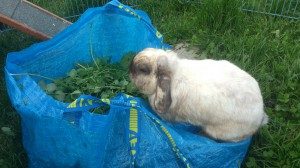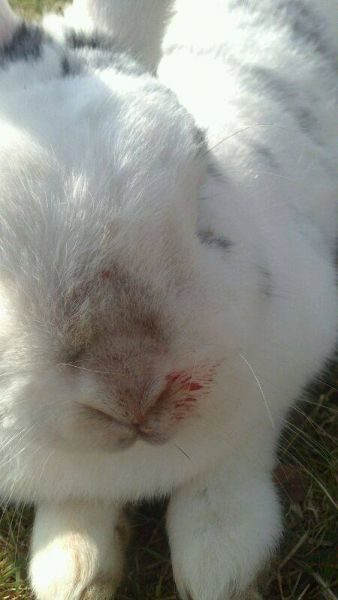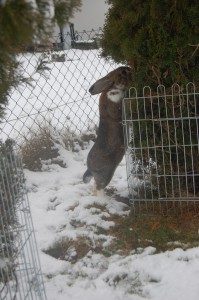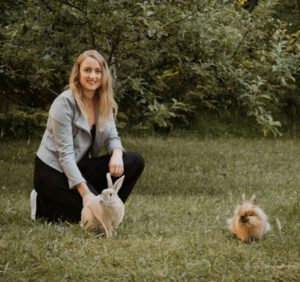Unfortunately, it is quite common for rabbits that previously showed no signs of illness to be suddenly found dead. Their owners then wonder what could have caused it. This page aims to help identify the possible cause and prevent such incidents in the future.

Important: Rabbit beginners often find their rabbits dead in the hutch without any obvious signs beforehand. This is because newcomers are less familiar with rabbit behavior and lack knowledge about their needs. As a result, they may overlook illnesses or misinterpret symptoms. Rabbits tend to hide signs of illness until it is often „too late.“
This can be easily prevented by checking twice daily to ensure that the rabbits are moving normally (not sitting still more than usual), eating properly, and producing healthy poops. Any change in behavior is a sign of acute illness. For example, if a normally shy rabbit suddenly allows itself to be petted or picked up, this is a warning sign.
It is also life-threatening if a rabbit eats less, stops eating altogether, or moves less than usual! If these symptoms appear, a rabbit-savvy veterinarian must be consulted immediately, regardless of the time (emergency service!). Waiting is not an option!
Contents
- The Most Common Causes
- Gastrointestinal Diseases
- Emergency Medication
- Predators
- Heart Diseases
- Kidney Diseases
- Rabbit Hemorrhagic Disease (RHD & RHD2)
- Accidents
- Heatstroke
- Poisoning?
- Fatty Liver
- Coccidiosis
- Bacterial Infections of the Digestive System
- Can I leave the partner rabbit alone?
- Unclear cause of death – Should the rabbit be buried?
- Unclear cause of death – An autopsy to clarify the cause
The Most Common Causes
Gastrointestinal Diseases
These can quickly become life-threatening for rabbits, often leading to death within just a few hours. Improper feeding, intestinal parasites, or dental issues can rapidly cause severe conditions such as gastric dilation, bloating, constipation, or diarrhea. Stomach overload is also a possible concern.
Diarrhea can be identified by examining the rabbit’s poop. Other gastrointestinal diseases are recognizable when a rabbit stops eating or eats less, moves less or not at all, and sits puffed up or hunched in a corner. Most affected rabbits become less responsive to their surroundings—for example, they may not come when food is offered or when the hutch is opened. They may also ignore treats or not show interest in them as they usually would.
Emergency Medication
It’s helpful to have the following medications in a home emergency kit, which can be mixed as needed:
- Sab Simplex (1ml)
- RodiCare akut
- Novalgin
A gastrointestinal disease is fatal if left untreated. Immediate attention from a rabbit-savvy emergency veterinarian is essential!
Predators
Not all predators take their prey or inflict serious injuries. Often, there are few traces left behind, and the animal remains unharmed. Foxes and martens are common culprits, but dogs also regularly kill rabbits.
To protect rabbits from dogs, a strong and sufficiently high fence is essential. Many rabbits die in small outdoor enclosures because a dog chases them around. They suffer from shock or run into the fence. Small enclosures, especially without a place to retreat, are a death trap.
Consider that predator attacks are one of the most common causes of death in outdoor housing. Predators are everywhere—even in cities. During twilight hours and at night, rabbits must be kept in enclosures that are absolutely secure against martens and foxes! And predators will return if they’ve found prey in a garden before.
It’s not a solution to lock the animals in a hutch at night. Apart from the fact that these enclosures are often not even marten-proof and need to be retrofitted (with secure locks, sturdy back walls, etc.), such housing is not suitable for rabbits. Rabbits also need space to move around at night, as they do not sleep through the night like humans, birds, or chickens do. Rabbits are crepuscular and especially active during twilight hours. Build your rabbits a secure enclosure that is completely marten- and fox-proof.
Heart Diseases
It can actually happen that a rabbit suddenly „collapses and dies.“ Sudden cardiac arrest is also possible in rabbits. However, most „sudden deaths“ attributed by owners to heart disease actually have other causes. Sudden cardiac death is extremely rare with proper diet and care. The cause could be an undetected or known heart condition, or a previous heart attack. Heart muscle diseases can also be a factor.
Kidney Diseases
Kidney diseases, especially chronic kidney failure, often go unnoticed in rabbits. Affected rabbits may drink slightly more, eat a bit less, and move less. Often, owners perceive this behavior as a sign of old age, but because it develops gradually, many owners overlook it. The coat may also become dull over time.
To prevent this cruel death, it is important to feed rabbits exclusively fresh food. Rabbits are herbivores and can develop kidney diseases as a result of too-dry diets. Additionally, the rabbit should be carefully observed, and any signs of illness should be noted. Kidney failure can also occur suddenly, for example, due to the pathogen E. Cuniculi, which attacks the kidneys. In older rabbits, it is advisable to have a blood test performed at the slightest suspicion or as a preventive measure.
Rabbit Hemorrhagic Disease (RHD & RHD2)
Warning: Currently, RHD2 is particularly active in Germany! The entire country is considered an outbreak zone. Rabbits that are not specifically vaccinated against RHD2 are dying in large numbers…
Especially when several rabbits from the same group die at the same time or in quick succession, or when healthy rabbits are suddenly found dead without any prior symptoms, it is usually due to RHD or RHD2. Affected animals may show no or only very nonspecific signs of illness, and they die extremely quickly after a painful struggle. The virus can be detected in the deceased animal. A vaccination for prevention is available—please seek information about it.
Unfortunately, we frequently hear of cases where rabbits were vaccinated, but only against RHD and not RHD2. In this case, the vaccinating veterinarian is the correct point of contact, as they should have informed the owner about the RHD2 vaccination and administered it.
In France, a new variant of RHDv-2 is currently circulating, against which the vaccine provides insufficient protection. This strain does not respect national borders, and cases are possible, especially near border regions. If RHD2-vaccinated rabbits die from RHD2, the variant of RHD2 should be specifically identified.

Warning: Under no circumstances should animals that suddenly die be buried in the garden! RHD can survive for years underground and is brought to the surface by digging animals, small soil organisms like worms, and gardening activities, continuing to cause death to other animals for years. Affected animals must be sent to pathology and should be disposed of by the veterinarian or cremated at an animal crematorium.
Accidents
Accidents are also a significant cause of death, such as getting stuck with their hind legs in grids. This is especially common when rabbits have open-top hay racks, can jump onto a cage lid, or get caught on an open cage door (if it is not covered). In these situations, they often break their spine or die painfully. However, these causes are usually recognizable.
Also easily recognizable are cases where rabbits run into the enclosure’s grid out of panic. While this is usually not fatal, in some cases, it can lead to death, such as from internal bleeding. Other accidents are also possible. To prevent rabbits from running into the cage grid, provide many hiding spots, place an opaque barrier at the lower part of the enclosure, and use a large enclosure.
Small enclosures are particularly dangerous and can become death traps when predators chase around them. In these cases, rabbits may die from shock without visible injuries.
Heatstroke
Rabbits are very sensitive to heat, and at higher temperatures, they often suffer from heatstroke (sometimes even despite being in the shade and having water). Therefore, it is crucial to regularly monitor rabbits when the temperature reaches 35°C (95°F) or higher. Adjust the shade and ensure adequate cooling: Protect rabbits from the heat.
Poisoning?
Poisoning is almost never a common cause of death in rabbits, although it is often mistakenly attributed to a plant they may have eaten. Plants like ivy, thuja, potato greens, or tomato plants are not actually toxic to rabbits, as long as they are not the sole food source. There are only a few plants that, in rare cases, can cause poisoning, such as yew.
Poisonings more commonly occur due to the incorrect administration of medications, often when drugs not suitable for rabbits—typically meant for dogs or cats—are used. Other medications may be fatal for weakened animals, or the veterinarian might incorrectly adjust the dosage. Pesticides and other chemical substances can also be toxic. When foraging for wild plants, it is important to ensure that the field was not recently treated with chemicals like pesticides or fertilizers. In the garden, such substances should only be used with great care and expertise, ensuring animals are kept away from treated areas for a sufficient amount of time.
For more information on poisonings, please consult a professional.

Fatty Liver
A not uncommon cause of sudden death in rabbits is fatty liver, which arises from an unhealthy diet and/or insufficient exercise. The main causes are commercially available dry food and cage housing. These animals usually die without significant symptoms.
Coccidiosis
Unfortunately, coccidiosis often leads to mass deaths in young rabbits, and in rarer cases, it can affect adult rabbits as well. Coccidiosis is the number one cause of death in young rabbits.
Bacterial Infections of the Digestive System
There are various bacteria that can cause inflammation of the digestive system (e.g., Clostridia or Klebsiella variicola). Affected rabbits suddenly become ill, withdraw, refuse food, and stop participating in their daily activities. Some may not pass any feces or may only pass slimy stools. The rabbits may have a fever or low body temperature, and their stomach will be painful when palpated.
These bacteria are contagious, and when introduced into a group, young rabbits or those under three years old are particularly affected. The younger the rabbit, the more likely the untreated condition will result in death.
Rabbits usually die very suddenly after a short acute illness, and mass deaths are often observed, especially among younger rabbits.
Can I leave the partner rabbit alone?
You can find more information about this topic here: Rabbit died – can you keep them alone?
Unclear cause of death – Should the rabbit be buried?
Under no circumstances should a rabbit be buried when the cause of death is unclear, as this actively contributes to the spread of RHD(2). Currently, most causes of death in rabbits are due to RHD(2). If the rabbit is buried, the virus can be brought to the surface again by digging animals, gardening activities, and small organisms such as worms, potentially causing another RHD outbreak with hundreds or thousands of dead rabbits.
Bring the animal to the veterinarian for proper disposal or have it cremated!
Unclear cause of death – An autopsy to clarify the cause
If the cause of death is unclear, it may be useful to have a pathological examination (autopsy) performed. This is especially important if there are other rabbits that might also be at risk. Your veterinarian can advise on where to send the animal for an autopsy.
Often, without an autopsy, it is impossible to definitively determine whether the rabbit died from the suspected cause, leaving room for speculation and sometimes even unfounded theories.
Therefore, in case of doubt, the rabbit should be sent for an autopsy promptly!
For this process, the rabbit should not be frozen (depending on the type of examination), but should be kept cool. For example, you can place it in a sealed bag in the refrigerator or store it in a box with cooling pads or ice. The latter method is also suitable for shipping.




















